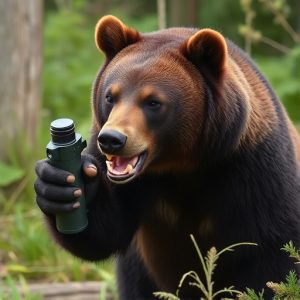Bear Spray vs Regular Pepper Spray: Effectiveness & Best Practices
Bear spray, a specialized form of pepper spray with higher capsaicin concentrations, is designed to…….
Bear spray, a specialized form of pepper spray with higher capsaicin concentrations, is designed to deter predatory bears like grizzlies and black bears, offering users crucial time to escape. It's distinguished from regular pepper spray by its longer range, stronger concentration, and added odor repellent, making it more effective against larger wildlife. While bear spray is tailored for specific bear encounters, regular pepper spray serves broader self-defense needs but has shorter range and lower potency. Understanding these differences and best practices for using bear spray, such as maintaining it and using it as a last resort, is vital for safety in bear-inhabited areas.
In the wild, encountering predators like bears can be a frightening prospect. Bear spray, a popular defense mechanism, offers an effective solution. This article delves into the world of bear spray, exploring its composition, effectiveness, and distinct advantages over regular pepper spray. We’ll guide you through best practices for using bear spray, ensuring you’re prepared when facing potential threats in nature. Discover why understanding this powerful tool is crucial for outdoor enthusiasts navigating wild landscapes.
- Understanding Bear Spray: Its Composition and Effectiveness
- Bear Spray vs Regular Pepper Spray: Key Differences
- Best Practices for Using Bear Spray as a Defense Mechanism
Understanding Bear Spray: Its Composition and Effectiveness
Bear spray, also known as bear defense spray, is a specialized pepper spray designed for use against bears. Unlike regular pepper spray, which primarily targets human aggressors, bear spray is formulated to deter predatory bears such as grizzly and black bears. Its composition differs in that it contains capsaicin, the active ingredient found in chili peppers, but at a much higher concentration. This potency is crucial for repelling large, powerful animals like bears.
The effectiveness of bear spray lies in its ability to create a temporary blindness and severe irritation when sprayed directly into an animal’s eyes and face. When used correctly, it can give individuals time to retreat or distract the bear long enough to escape potential danger. Moreover, understanding the differences between bear spray and regular pepper spray is essential. Bear spray is specifically designed for larger wildlife and can be more effective at longer ranges, making it a valuable tool in bear country.
Bear Spray vs Regular Pepper Spray: Key Differences
Bear spray and regular pepper spray share some similarities, but they are designed for different purposes and environments. While both use capsaicin to cause a burning sensation and temporary blindness, bear spray is formulated specifically to deter larger predators like bears. It typically has a longer range and stronger concentration than regular pepper spray, making it more effective at keeping bears at bay. Additionally, bear spray often includes an odor that repels bears, giving users a greater chance of escape in grizzly encounters.
Regular pepper spray, on the other hand, is primarily designed for self-defense against smaller predators or human aggressors. It can still be effective against bears up close, but its shorter range and lower concentration make it less reliable as a bear deterrent. The key difference lies in their applications; bear spray is specialized for bear encounters while regular pepper spray serves broader self-defense needs.
Best Practices for Using Bear Spray as a Defense Mechanism
When considering bear spray as your primary defense mechanism, understanding its unique properties and best practices is crucial. Unlike regular pepper spray, bear spray is specifically designed to deter bears, with a stronger concentration of capsaicin, the active ingredient causing irritation. It’s essential to remember that bear spray should only be used as a last resort when facing an aggressive bear encounter.
Best practices include ensuring proper training and understanding the spray’s range and effectiveness. Users should practice aim and spacing, as bear spray is most effective at close range (up to 25-30 feet). It’s also vital to stay calm and follow safety protocols, such as backing away slowly while spraying in the bear’s face. Regular maintenance of your bear spray, like checking expiration dates and keeping it readily accessible, is key to ensuring its readiness when needed.
Bear spray has established itself as an effective defense mechanism against predators, especially in areas frequented by bears. When compared to regular pepper spray, bear spray offers specialized protection with a wider range and longer-lasting effect, making it ideal for outdoor enthusiasts and those living in bear country. By understanding its composition, differences from conventional pepper spray, and best practices, individuals can enhance their safety when facing potential threats from predators. Remember, proper usage is key to ensuring its effectiveness as a last line of defense.


